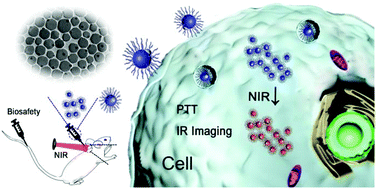Janus Ag/Ag2S beads as efficient photothermal agents for the eradication of inflammation and artery stenosis†
Abstract
Janus heterostructural materials as photothermal agents with enhanced optical conversion capability are promising for artery inflammation treatment by the hyperthermia of macrophages, a primordial part in the artery inflammation response that can deteriorate into atherosclerosis and even break the vessels. Herein, a synthesis route of Janus Ag/Ag2S beads with hydrophilic ligands has been developed with a precise control over concentration, time and surface functionalization. These Ag/Ag2S heterodimers show desirable sizes of around 90 nm in diameter, in which Ag nanocrystals have a diameter of around 25 nm, and they exhibit a photothermal conversion efficiency of up to 50.0% as well as relatively low biotoxicity and good biocompatibility. Importantly, the as-prepared Janus Ag/Ag2S beads with a high biological safety can be effectively swallowed by macrophages and have a remarkable benefit of eliminating these cells from the original state of artery inflammation through the excellent photothermal effect of this material, without causing any further damage to the arteries and major organs in vivo. This study further promotes the development of treatment for vascular inflammation by the photothermal melting of macrophage cells in intima environments.

- This article is part of the themed collection: Nanoscale 10th Anniversary Special Issue


 Please wait while we load your content...
Please wait while we load your content...